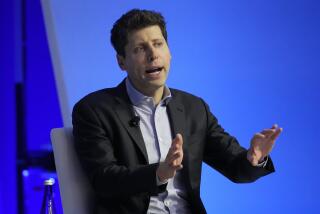BOOK REVIEW / NONFICTION : Thinking Machines Are All in the Mind : THE ENGINE OF REASON, THE SEAT OF THE SOUL: A Philosophical Journey Into the Brain<i> by Paul M. Churchland</i> , MIT Press, $29.95, 329 pages
- Share via
We are all flesh and blood, and that’s all we are. Yet we have the feeling that there is something more inside each of us, something that gives rise to our thoughts, our emotions, our beliefs, our personas--a vital spirit, a soul, if you will--something that transcends flesh and blood.
No one knows what this something else is, and, almost by definition, no one can put a finger on it. On the other hand, a neurosurgeon who opens your brain cannot see your thoughts, either. Whatever else it is, the mind is certainly elusive.
On this issue, the world is divided into two camps: Those who believe that mental phenomena are special and do not follow the known laws of chemistry and physics, and those who believe that every mental state--every nuance of feeling--can be associated with a discrete and knowable biochemical state of the brain.
This argument, which has been going on for centuries, has gotten renewed attention in recent years as scientists and philosophers have learned more and thought more about it.
The debate has been propelled by the computer scientists who are trying to make machines think like humans--so far, at least, without much success. Does their failure indicate that it cannot be done or simply that they haven’t yet figured out how to do it?
Paul M. Churchland, a distinguished philosopher at the University of California, San Diego, believes wholeheartedly and resolutely that all mental phenomena can be reduced to neural phenomena. In his view, there is nothing special about consciousness and cognition. They simply result from the chemical processes going on inside our heads. We are biochemical machines who walk around and talk to each other.
Churchland lays out his argument in “The Engine of Reason, the Seat of the Soul,” a very important book full of tantalizing and astute observations and insights about consciousness, thinking and thought. Its sweep encompasses morality, politics, the arts, education, penology, psychiatry and the very nature of freedom itself. This is a book to be reckoned with.
“Can we reconstruct all known mental phenomena in neurodynamical terms?” Churchland asks. “Not at the moment, we can’t. Not by a long shot.” To be sure, he goes on, “Explaining the many dimensions of consciousness is a daunting task, but it is a scientific task that we can already see how to pursue.”
The trick, he says, lies in the emerging branch of artificial intelligence called neural networks, which seeks to give computers the basic outlines of a task and then let them learn by doing it.
Churchland calls this theory “neurocomputation,” and he believes that it accounts for all of the thinking, feeling, daydreaming, creating, problem-solving and moralizing that we do. It accounts for every last iota of our mental lives.
He spends several chapters describing how it’s done with computers and giving examples of limited successes, such as a computer being able to recognize faces even when parts of them are hidden--just as you and I can do. The most interesting part of this approach is that the computer gets better at the task each time it does it.
Traditional artificial intelligence--going back to the 1950s--seeks to write explicit computer programs that mimic, step by step, the thought processes of a human brain. This approach has failed.
The brain doesn’t work that way. Besides, human thinking is much more pliable, elastic and inventive than a lock-step computer program. Neural networks cleverly emphasize the elasticity and inventiveness parts.
Typically, artificial intelligence has been able to achieve some success as long as the problem was very narrowly defined and very limited. For example, if you give a computer a small vocabulary--1,000 words or so--on a single topic, it can sort of “understand” written sentences.
But if you give it an unlimited vocabulary on unlimited topics, the machine falls flat on its face. Neural networks have shown some promise of being able to overcome this problem, but so far the promise is largely unfulfilled.
Churchland has chosen the most impressive examples of work in the field. It remains to be seen whether they will ultimately lead to the breakthroughs that he envisions.
If they are successful, the implications are staggering, and Churchland spends the last part of the book considering some of them. His antepenultimate chapter asks the question, “Could an Electronic Machine Be Conscious?” His answer:
“It rather looks as if it will be possible to construct an electronic machine that is as truly conscious as you or I. So far, that dramatic possibility remains wide open.”
Churchland is no New Age mystic. He writes with wit and grace, and his points are grounded in substantive research and careful thought. He repeatedly acknowledges that he may be wrong about all of this. But on the other hand, he may be right.
More to Read
Sign up for our Book Club newsletter
Get the latest news, events and more from the Los Angeles Times Book Club, and help us get L.A. reading and talking.
You may occasionally receive promotional content from the Los Angeles Times.










